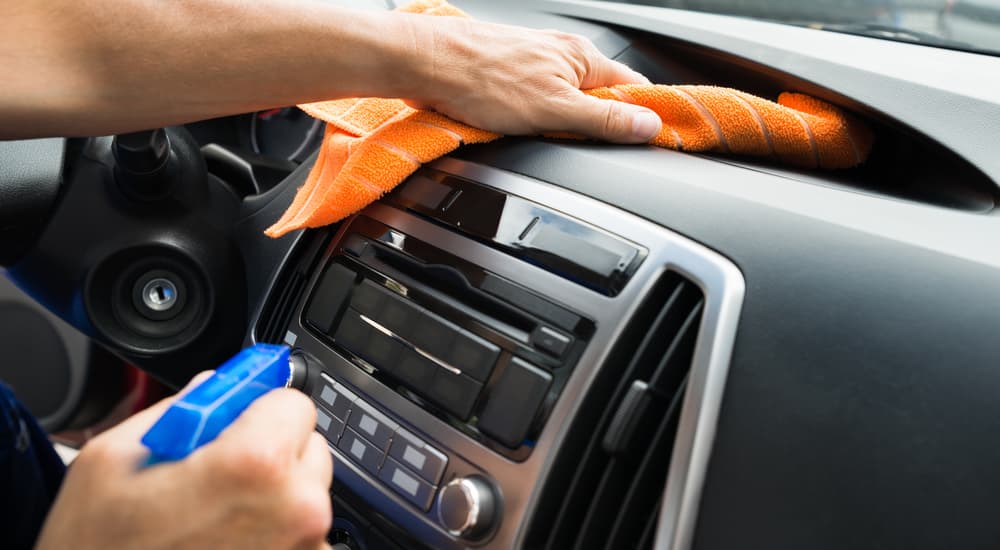Washing a car can feel pretty simple, but if you want to keep your vehicle in top condition, there are more pitfalls than you might think. Even models that are built to be tough as nails can be sensitive to the wrong cleaning products and techniques, and you don’t want to find out which ones by experience. So let’s take a look at what NOT to do when cleaning your car, whether you’re getting the exterior nice and shiny, detailing the interior, or both. Avoid these mistakes, and you’ll have your car looking and smelling like new in no time, so you can impress your co-workers, provide a clean environment for your kids, and maintain as much of your car’s value as possible.
Exterior: Don’t Wash a Hot Car
A hot summer day might feel like the perfect time to wash your car since you won’t mind if you get splashed with the hose. Unfortunately, too much heat can work against you by drying up the soap and water too quickly. If the soap dries before you have time to rinse it off, it’s more likely to form deposits and leave your car looking less than perfectly clean. So don’t break out the cleaning products and water bucket while the engine is still cooling down after a long drive or at high noon during a heat wave.
Interior: Don’t Disinfect With Bleach or Ammonia
We don’t blame you for wanting to ensure your car’s interior is free of germs. If you have young kids who are always catching the latest bug or drive for a ride-share company and have strangers coming and going daily, it makes sense to want to disinfect your vehicle regularly. But grabbing a bottle of bleach or ammonia isn’t the answer. Both can be harsh, bleach can discolor your upholstery, and ammonia can damage the plastic coating of your touchscreen. You’re better off wiping down with a spray that’s designed for detailing or using a small amount of mild soap diluted in water. And while we’re on the subject of bleach and ammonia, remember that no matter what you’re cleaning you should NEVER combine the two! Mixed together, these common household products combine to make a toxic gas that can be harmful or even deadly.
Both: Avoid “Cleaning Hack” Solutions
There are all kinds of life hacks floating around on the internet that let you know how you can clean your car with common household cleaning agents. These solutions sound appealing because they’re cheap and easy, but the risks often outweigh the rewards. For example, dish soap and hand soap can definitely tackle grease and might seem like reasonable choices for cleaning your car’s exterior. But they just weren’t made to be used on your car, meaning they can eat away at protective wax or paint sealant, exposing your paint to the elements. Magic Erasers aren’t the easy solution they seem like either; they’ll almost certainly dull your paint. Stocking up on dedicated car wash products may cost you a little money upfront, but replacing them with cheaper alternatives that aren’t right for the job can result in costly repairs down the road.

Exterior: Don’t Rely on an Air Dry
After spending an afternoon scrubbing down every nook and cranny of your car’s exterior, it can be tempting to let it dry by cruising around the block or even just letting it sit out in the open. But while air drying may be easy, it doesn’t provide the best results. You’ll likely end up with unsightly streaks and feel compelled to start all over with the wash. Instead, you can use a soft towel or microfiber cloth to dry everything down when you’re done.
Interior: Don’t Forget the Air Vents
Getting into the depths of the AC/heating air vents can definitely be a pain, and it can be tempting to skip them altogether. But dirty vents can mean dirty air is circulating in your car since the area right at the mouth of the vent is outside your HVAC filter’s area. Instead of going at it with a rag, try using compressed air to blow the dirt loose or a tub of cleaning gel designed to reach into tough spots like these vents and bring back all the dirt it touches. If you go this route, make sure not to leave the gel out where it can get too hot, since it’s no longer useful if it melts.
Both: Don’t Be Too Harsh
If you’re tackling a tough stain or a stubborn bit of debris, it can be tempting to put all of your strength into scrubbing or scraping it. But remember that you’re also applying that power to your car’s upholstery or paint, which can end up causing more harm than good if you’re not careful. Take a deep breath, be patient, and double-check the instructions on the cleaning product you’re using. It might not be right for this particular job, or you might have to let it soak in for a set amount of time before it can work its magic.

Exterior: Don’t Use Circular Motions
If you’re a fan of The Karate Kid, you might find yourself imitating the “wax on, wax off” scene while cleaning your car’s exterior, but you’re best off resisting that urge. When you’re washing your car, moving in circles can scratch the debris over the surface of your paint and create swirl marks. Use lengthwise motions instead, and make sure to rinse off everything with water before you start scrubbing to minimize the amount of debris from the start. And don’t worry — Mr. Miyagi didn’t lie to you. Circular motions are perfectly fine to use when actually applying car wax since you’re working with a car that’s already clean at that point and should be using a very soft cloth.
Interior: Don’t Let the Seats Get Soaked
If you’re thoroughly cleaning your car’s interior, the seats are going to get at least somewhat wet. That’s nothing to worry about. However, you should avoid letting them get completely soaked and have a plan in place to help them dry off quickly. Some cleaning products need to be rinsed out with water after they’ve had time to set, but use a cloth dipped in water instead of just pouring water directly onto the seats. Blot up as much of the moisture as you can with a dry towel before leaving the interior to air dry.
Both: Don’t Jump Right in With a New Cleaning Product
Even if you’re sticking to products designed for automotive use (which you should), you still have to account for the fact that each model is unique. Different cars use different materials, so cleaning products aren’t one-size-fits-all. Instead of jumping right in and starting to clean all of your upholstery or the entire exterior of your car with a product you’ve never used before, try a spot test first. Pick a small spot that’s not in a highly visible location and test the product out there to make sure it won’t cause any problems, like discoloration. This is an especially good idea if you have a luxury model that might be particularly sensitive to harsh cleaners and expensive to repair or an older vehicle that might use materials that are no longer common since modern cleaning products may have marched on and left them behind.

